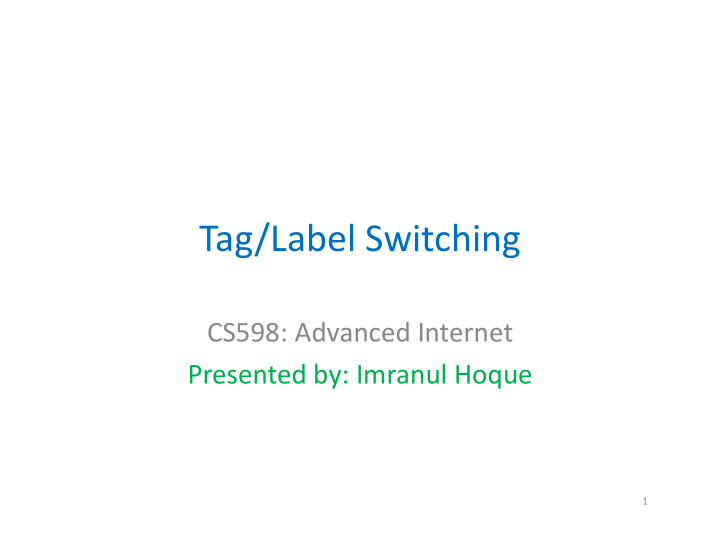



Tag/Label Switching CS598: Advanced Internet Presented by: Imranul Hoque 1
How to go from A to B? • Broadcast: – Go everywhere, stop at B – Never ask for directions • Hop by hop routing: • Hop by hop routing: – Ask who is closer to B, go there, repeat! – You better go to X first … • Source routing: – Get a list before starting – Go straight 5 blocks, take a left, 4 more blocks, … 2
How to go from A to B? • Let someone go ahead of you • At every road reserve a lane for you • At intersection, post a sign (turn + lane) Lane #1 Lane #2 Lane #2: turn left, use lane #1 3
What is it good for? • Enable IP capabilities on devices that cannot forward IP datagrams • Explicit routing – pre-calculated routes that do not match normal IP routing paths not match normal IP routing paths • Virtual Private Network (VPN) services 4
What is it good for? • Enable IP capabilities on devices that cannot forward IP datagrams • Explicit routing – pre-calculated routes that do not match normal IP routing paths not match normal IP routing paths • Virtual Private Network (VPN) services One of the original goals is not on the list! 5
This Talk • History • Learn from Examples – Destination-based Forwarding – Explicit Routing Explicit Routing – Virtual Private Networks and Tunnels • Points to Ponder – What layer is MPLS? • Where is MPLS now? 6
History • Ipsilon Networks – IP switching, defined to work on ATM • Cisco Systems, Inc. – Tag switching, proprietary proposal Tag switching, proprietary proposal – Renamed label switching – Handed over to IETF • IETF – Proposals from other vendors (Toshiba, IBM) 7
Destination-Based Forwarding 8
Benefits • Exact match, as opposed to longest match – Simple to implement in hardware • Forwarding Equivalence Class (FEC) – Set of packets that receive same forwarding – Set of packets that receive same forwarding treatment • Devices not supporting IP can forward IP traffic – Example: carry IP traffic over ATM switches – How and Why? 9
How? • Provide switches with: – IP routing protocols – A method to distribute label bindings (LDP) • Result: IP control protocols with label- Result: IP control protocols with label- swapping forwarding 10
Why? Set of routers connected over an ATM network (why?) ATM switches are replaced with LSR (benefits?) 11
Explicit Routing • Questions: – How to routers agree on what labels to use and how to forward packets with particular labels? 12
Applications of Explicit Routing • Traffic Engineering – Controlling exactly which path the traffic flows • Resilience in face of failure – Reroute traffic down a pre-calculated path Reroute traffic down a pre-calculated path – Known as Fast Reroute 13
Applications of Explicit Routing • Traffic Engineering – Controlling exactly which path the traffic flows • Resilience in face of failure – Reroute traffic down a pre-calculated path Reroute traffic down a pre-calculated path – Known as Fast Reroute How to calculate the explicit routes? 14
Virtual Private Networks • “Layer 2” VPN – Tunnel layer 2 data (Ethernet frames/ATM cells) – Pseudo-wire emulation 15
Virtual Private Networks • “Layer 2” VPN – Tunnel layer 2 data (Ethernet frames/ATM cells) – Pseudo-wire emulation What to do with non-IP traffic when it reaches the EOT? 16
VPN: ATM over IP • Labels may be stacked on a packet to any depth • A single tunnel can carry potentially large number of emulated circuits • Same technique to provided hierarchy of routing knowledge 17
What Layer is MPLS? • Layer 2.5 • Layer 2 • Layer 2 • Layer 3 18
What Layer is MPLS? • Layer 2.5 – MPLS header is found between layer 3 and layer 2 headers • Layer 2 • Layer 2 – IP packets are encapsulated inside MPLS headers – MPLS must be below IP • Layer 3 – MPLS uses IP routing protocols and IP addressing 19
Where is MPLS Now? • Sufficiently popular among service providers – Almost all high-end routers include MPLS capabilities • Two main applications: • Two main applications: – Layer 3 VPN: Provide “private” IP services to corporations – Explicit Routing: TE and/or Fast Reroute • Difficult to determine how many providers are actually using this technology 20
Questions? 21
Recommend
More recommend